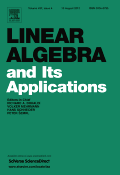
LINEAR ALGEBRA AND ITS APPLICATIONS
Scope & Guideline
Unveiling the Power of Linear Algebra Across Disciplines
Introduction
Aims and Scopes
- Theoretical Development in Linear Algebra:
The journal publishes papers that contribute to the foundational aspects of linear algebra, including matrix theory, eigenvalue problems, and linear transformations. This includes new theoretical results, proofs, and discussions that advance the understanding of linear algebraic structures. - Applications in Graph Theory:
A significant portion of the research focuses on the application of linear algebra in graph theory, exploring topics such as spectral graph theory, adjacency matrices, Laplacian matrices, and their implications on graph properties and behaviors. - Numerical Linear Algebra:
The journal emphasizes numerical methods and algorithms in linear algebra, including iterative methods, matrix factorizations, and stability analysis. This area addresses computational aspects and the efficiency of algorithms for solving linear systems. - Interdisciplinary Applications:
Research often explores the interdisciplinary applications of linear algebra in fields such as quantum mechanics, statistics, control theory, and optimization. The journal highlights how linear algebra techniques can solve complex problems in various domains. - Matrix Inequalities and Operator Theory:
The journal includes studies on matrix inequalities, operator theory, and their implications in functional analysis, focusing on the relationships between matrix properties and operator behaviors.
Trending and Emerging
- Quantum Computing and Linear Algebra:
There is a growing interest in the intersection of quantum computing and linear algebra, particularly in the development of algorithms that leverage linear algebra techniques for quantum systems and quantum information theory. - Graph Neural Networks and Spectral Methods:
The application of linear algebra in the development of graph neural networks, particularly spectral methods, is emerging as a significant trend, showcasing the relevance of linear algebra in machine learning and data science. - Matrix Analysis in Optimization:
Research focusing on the application of matrix analysis in optimization problems has gained prominence. This includes the study of matrix inequalities, convexity, and their implications in optimization theory. - Higher-Dimensional Linear Structures:
A trend towards exploring higher-dimensional linear structures, including tensors and multilinear algebra, is emerging. This reflects an increasing interest in complex data representations and their applications. - Topological and Geometric Aspects of Matrices:
The exploration of topological and geometric properties of matrices, particularly in relation to their spectra and eigenvalue distributions, is gaining traction, indicating a shift towards a more geometrical understanding of linear algebra.
Declining or Waning
- Classical Matrix Theory:
Research focused on classical matrix theory and its foundational aspects has seen a decline in favor of more applied and interdisciplinary studies. While foundational work remains important, the trend has shifted towards practical applications and computational methods. - Traditional Eigenvalue Problems:
Although eigenvalue problems remain a core topic, there has been a noticeable shift towards more complex, structured, and generalized eigenvalue problems rather than traditional approaches. The focus is now more on applications and numerical methods rather than solely theoretical discussions. - Elementary Linear Algebra Concepts:
Papers that cover basic concepts of linear algebra, such as elementary row operations or introductory matrix algebra, have decreased. The journal seems to favor advanced topics that contribute to new methodologies or applications.
Similar Journals

Aequationes Mathematicae
Charting New Territories in Combinatorial Studies.Aequationes Mathematicae is a distinguished academic journal published by SPRINGER BASEL AG, focusing on the dynamic fields of Applied Mathematics, Discrete Mathematics, and Combinatorics. Since its inception in 1968, the journal has served as a vital platform for disseminating high-quality research, with Converged Years expected to extend to 2024. With an impressive Q2 ranking in multiple mathematical disciplines as of 2023, Aequationes Mathematicae is positioned within the top half of its field, reflecting its reputation for excellence. Spanning the globe from its base in Basel, Switzerland, this journal is ideal for researchers, professionals, and students seeking to advance their knowledge and contribute to ongoing discussions within mathematics. While it does not currently offer Open Access options, readers can still access an extensive archive of impactful studies that bolster its standing within the academic community.

Operators and Matrices
Fostering Groundbreaking Insights in Operators and MatricesOperators and Matrices is a distinguished academic journal dedicated to the fields of algebra, number theory, and analysis, published by ELEMENT. Operating from Croatia since its inception in 2009, this journal provides a vital platform for groundbreaking research, aiming to foster advancements in mathematics through the publication of high-quality articles. With an ISSN of 1846-3886, it has secured a respectable Q3 category ranking in both the Algebra and Number Theory and Analysis categories according to the latest metrics. Current Scopus rankings position it at #83/119 in Algebra and Number Theory and #153/193 in Analysis, indicating its growing influence in the academic community. Although it does not provide open access, the journal strives to promote a robust exchange of ideas and methodologies that illuminate complex mathematical concepts, thereby appealing to researchers, professionals, and students alike. By contributing to Operators and Matrices, scholars can place their work within a significant context, advancing their professional footprint in the mathematical landscape.
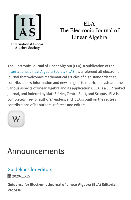
Electronic Journal of Linear Algebra
Exploring Innovative Insights in Linear Algebra.The Electronic Journal of Linear Algebra, published by the International Linear Algebra Society, is a pivotal platform for research and discourse in the field of linear algebra. With an ISSN of 1537-9582 and an e-ISSN of 1081-3810, this esteemed journal has been disseminating cutting-edge findings since its inception in 1996 and will continue through to 2024. Situated in the United States, at the University of West Florida, the journal has garnered recognition within the academic community, reflected in its Q2 quartile status in Algebra and Number Theory as of 2023, alongside a respectable Scopus rank of #62 out of 119. Although it operates as a non-open access journal, the Electronic Journal of Linear Algebra offers valuable insights and innovative approaches, fostering the development of linear algebra theory and its applications, making it a crucial resource for researchers, professionals, and students alike.

Random Matrices-Theory and Applications
Elevating the Study of Discrete MathematicsRandom Matrices-Theory and Applications is a premier academic journal published by World Scientific Publishing Co Pte Ltd, specializing in the intricate fields of algebra, number theory, discrete mathematics, and statistics. With its ISSN 2010-3263 and E-ISSN 2010-3271, the journal serves as a vital resource for researchers and professionals looking to explore the mathematical landscape of random matrices and their diverse applications across various disciplines. Since its inception in 2012, Random Matrices has achieved recognition in various quartiles, achieving Q2 standings in multiple categories including Algebra and Number Theory and Discrete Mathematics and Combinatorics, indicative of its influential research contributions and rigorous peer-review process. The journal is committed to disseminating high-quality research articles that drive innovation and facilitate knowledge-sharing within the global mathematics community. Scholars interested in advancing their understanding of statistical methodologies related to random matrices will find this journal an indispensable addition to their research toolkit.

JOURNAL OF OPERATOR THEORY
Advancing Mathematical Frontiers in Operator TheoryJOURNAL OF OPERATOR THEORY is a distinguished periodical published by the THETA FOUNDATION based in Romania. With a specific focus on the realms of mathematics, particularly in the areas of operator theory and its applications in algebra and number theory, this journal plays a crucial role in disseminating high-quality research that advances theoretical understanding and practical applications. It is indexed with an impressive rank of #58 out of 119 in the Scopus Mathematics category, placing it within the 51st percentile nationally. The journal has evolved significantly since its establishment, with publications spanning from 1996 through 2024, and maintaining a reputable stature in the Q2 quartile for Algebra and Number Theory as of 2023. While it operates under a subscription model, the JOURNAL OF OPERATOR THEORY remains an essential resource for researchers, professionals, and students seeking to engage deeply with contemporary mathematical issues and promote advancements in the field. For those looking to explore innovative findings and methodological approaches, this journal is indispensable.
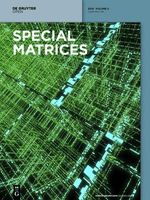
Special Matrices
Empowering Scholars to Share and DiscoverSpecial Matrices is an esteemed open-access journal published by DE GRUYTER POLAND SP Z O O, focusing on the advancement of research in the fields of algebra, number theory, geometry, and topology. Since its inception in 2013, the journal has carved out a niche for itself, earning its place in the Q3 category for both Algebra and Number Theory as well as Geometry and Topology in the 2023 rankings. With a commitment to fostering scholarly work that bridges various mathematical domains, Special Matrices serves as a platform for researchers and professionals to disseminate their findings and share innovative ideas. With this journal's open-access model, all published research is freely available, promoting broader accessibility and collaboration within the mathematical community. Whether you are a researcher, a student, or a professional looking to stay updated on contemporary issues and trends, Special Matrices is a valuable resource that supports the continuous dialogue and exploration in the realms of mathematical sciences.

ACTA SCIENTIARUM MATHEMATICARUM
Catalyzing Progress in Mathematical Analysis and ApplicationsACTA SCIENTIARUM MATHEMATICARUM, published by SPRINGER BIRKHAUSER in Switzerland, is a distinguished journal focusing on the fields of mathematical analysis and applied mathematics. With an ISSN of 0001-6969 and an E-ISSN of 2064-8316, this journal serves as a critical platform for disseminating high-quality research that bridges theoretical and practical aspects of mathematics. Although currently categorized in the Q3 quartile for both Analysis and Applied Mathematics as of 2023, the journal strives to enhance its impact on the mathematical community by offering a perfect blend of rigorous research and innovative applications. Researchers, professionals, and students can benefit from the journal’s commitment to advancing knowledge in mathematics, despite the absence of open-access options. The mailing address for correspondences is 233 SPRING STREET, 6TH FLOOR, NEW YORK, NY 10013. As mathematics continues to evolve, ACTA SCIENTIARUM MATHEMATICARUM positions itself as a valuable resource for those looking to contribute to and stay informed about the latest developments in this vibrant field.

Acta Universitatis Sapientiae-Mathematica
Transforming mathematical challenges into scholarly opportunities.Acta Universitatis Sapientiae-Mathematica is a dynamic and open-access academic journal published by SCIENDO, dedicated to advancing research in the field of mathematics. With its roots grounded in Germany, the journal has made significant strides in promoting scholarly contributions since it became open access in 2013, enhancing accessibility for researchers, professionals, and students alike. Spanning a broad spectrum of mathematical disciplines, including general mathematics, the journal engages with contemporary challenges and offers a platform to explore innovative approaches. Although currently positioned in the Q4 quartile for 2023 within the miscellaneous mathematics category and holding a Scopus rank of #290 out of 399, the journal is committed to fostering intellectual discourse and enhancing the overall quality of mathematics research. The convergence of research presented since 2014 showcases a journey toward improvement and expanding its influence in the mathematical community. Contribute to the vibrant dialogue in mathematics by exploring the latest findings in Acta Universitatis Sapientiae-Mathematica as it continues to evolve in the academic landscape.
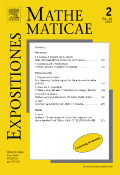
EXPOSITIONES MATHEMATICAE
Exploring Innovative Theories in MathematicsEXPOSITIONES MATHEMATICAE, published by Elsevier GmbH, stands as a significant journal in the realm of mathematics, catering primarily to researchers, professionals, and students. With an ISSN of 0723-0869 and an E-ISSN of 1878-0792, this journal has made its mark in the academic community, boasting a Q2 classification in the miscellaneous mathematics category for 2023, illustrating its prominence within its field. The journal addresses a diverse scope of mathematical topics, encouraging the publication of original research and innovative theories while maintaining rigorous academic standards. As it converges from 2004 to 2024, EXPOSITIONES MATHEMATICAE continues to be an essential resource for advancing mathematical knowledge and fostering scholarly communication, despite being a non-open-access publication. Its location in Munich, Germany further anchors it within a rich intellectual tradition, providing accessibility for the mathematical community worldwide.
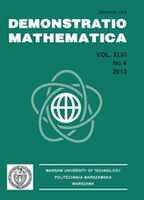
Demonstratio Mathematica
Unveiling the Beauty of Mathematical ConceptsDemonstratio Mathematica, published by DE GRUYTER POLAND SP Z O O, is an esteemed open-access journal in the field of mathematics, with an ISSN of 0420-1213 and E-ISSN 2391-4661. Established in 1996 and providing open access since 2009, it has become a vital platform for disseminating innovative research and advancements in various areas of mathematics. With a commendable Scopus ranking of 85/399 in General Mathematics and a 2023 Category Quartile of Q2, it stands at the forefront of the mathematical community, demonstrating a significant impact within the top 78th percentile. The journal aims to foster a deeper understanding and appreciation of mathematical concepts and their applications, catering to both seasoned researchers and emerging scholars. Located in Warsaw, Poland, Demonstratio Mathematica not only enriches the academic discourse but also strengthens collaborative efforts within the international mathematics community, making it an essential resource for those seeking to expand their knowledge and research output.